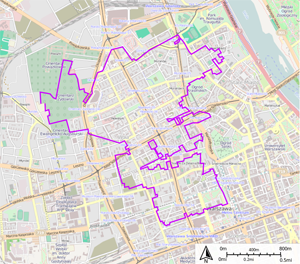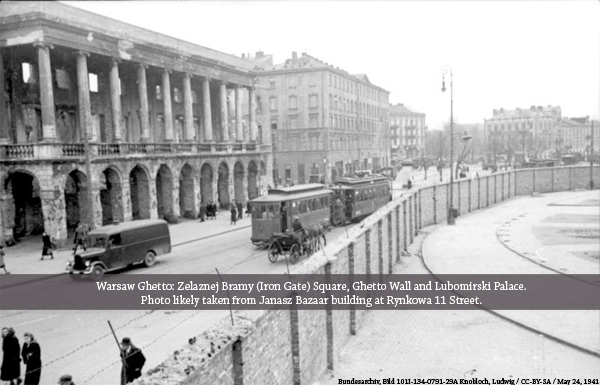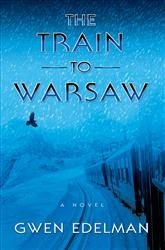Yesterday, Gwen Edelman wrote about a recent visit to Warsaw. Her most recent novel, The Train to Warsaw (Grove Press), is now available. She will be blogging here all week for Jewish Book Council and MyJewishLearning.
 Central Park, in the middle of the city of New York, is 843 acres. The Warsaw Ghetto, in the middle of the city of Warsaw, was 832 acres.
Central Park, in the middle of the city of New York, is 843 acres. The Warsaw Ghetto, in the middle of the city of Warsaw, was 832 acres.
One day you are walking down Fifth Avenue. You see stone masons slathering mortar on red bricks. A wall is going up. Around Central Park? How strange. There’s never been a wall around Central Park before. You ask one of the masons why they’re building a wall. He shrugs. He’s been told to build it. That’s all. He doesn’t know what it’s for. Another mason nearby says the same. What could it be for? To keep whom in and whom out? It’s all exceedingly strange.
This has not happened in New York City. But it did happen in Warsaw in November of 1940. From one day to the next, a six foot high red brick wall began to go up around the poorest part of the city. Several weeks later, signs appeared all over Warsaw. Jews were to move to the enclosed space behind the walls within two weeks, under pain of death. Jews from all walks of life were suddenly uprooted and forced to move to the poorest, most dilapidated part of town. In the space of a few weeks, they had to find an apartment, pack up all their worldly belongings on carts and wagons, and move into their new quarters where they found themselves squeezed into tenement apartments with other families. In the beginning there were visitors. Non-Jews going to say goodbye to friends, relatives, employers…
Soon the pieces of the mysterious walls were connected. There were twenty-three gates with armed guards at each one. And then the gates closed. In the middle of the city, a new universe came into being, shut off from the old. Inside there was no food. Because the caloric allotment for Jews was 86 calories a day, the smuggling between the two sides of the wall began immediately. The guards were paid off, the Poles on the “Aryan side” were paid. And the business of surviving began.

There are no apartment buildings and no streets in Central Park. But imagine that there were. Imagine that inside Central Park, there are only Jews. Invisible behind the walls. The life of the city goes on all around the walls. And inside? What is happening? You are walking down Fifth Avenue near the six foot high wall. As you pass one of the gates, you see Jewish laborers being marched out to work outside the ghetto. From your side of the wall you can see them throwing food and goods over the wall. You can see them burrowing through holes that have been carved out beneath the wall and in the middle of the wall. The smuggling is never ending — both from the ghetto side and the “Aryan side.” Bags of kasha and potatoes and sugar are thrown into the ghetto. Leather goods and textiles are thrown back. Contraband is brought through the gates in wagons or by smugglers, many of them children.
You can see them shooting Jews at the gate, shooting at Jews attempting to scale the wall. From inside you hear gunshots, shouts, screams. A reign of terror. And you can hear it, you can smell it. Another universe is in motion. The shooting, the screaming, the stench of blood and filth and corpses. The starvation. The trains that leave several times a day packed with Jews headed for Treblinka… On the other side of the wall, there’s a war going on. It’s not exactly peacetime outside the ghetto. But this is another world. It’s not far away, it’s not on the outskirts of town. It’s a walled kingdom of death right in the midst of the city.
This wasn’t Central Park, of course. This was Warsaw in 1940, 1941, 1942, 1943…
You cannot be oblivious to what’s going on inside those walls. Or can you?
Gwen Edelman’s first novel, War Story, was translated into eight languages, won the Prix du Premier Roman Etranger in France, and was a Koret Jewish Book Award finalist. Her most recent novel, The Train to Warsaw (Grove Press), is now available. Check back here tomorrow to hear more from Gwen.
Related Content:
- Reading List: Warsaw Ghetto
- Reading List: Treblinka
- The United States Holocaust Memorial Museum Encyclopedia of Camps and Ghettos, 1933 – 1945, Volume 1 edited by Geoffrey P. Megargee
- The Yad Vashem Encyclopedia of the Ghettos During the Holocaust edited by Guy Miren
- Everyday Jews: Scenes From a Vanished Life by Yehoshue Perle
- The Property by Rutu Modan


